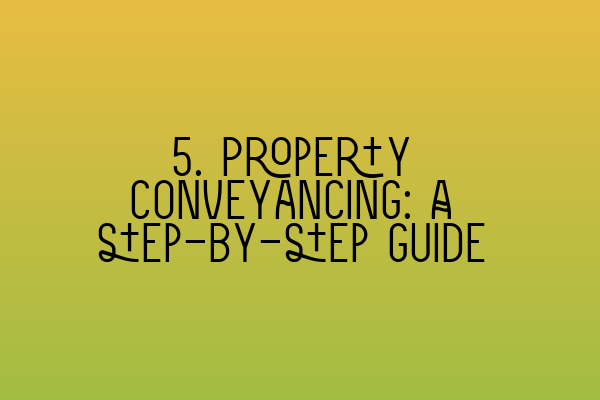Property Conveyancing: A Step-by-Step Guide
At SQE Property Law & Land Law, we understand that property conveyancing can be a complex process. Whether you’re buying or selling a property, it’s essential to have a firm grasp of the steps involved to ensure a smooth transaction. In this step-by-step guide, we’ll break down the conveyancing process to help you navigate through it successfully.
Step 1: Initial Consultation
The first step in the property conveyancing process is the initial consultation with your solicitor. During this meeting, you’ll discuss your requirements and objectives, including your desired timeline and budget. Your solicitor will also explain the legal obligations and potential risks associated with property transactions.
Step 2: Instruction of the Solicitor
Once you’ve chosen a solicitor, you’ll need to formally instruct them to handle your property conveyancing. This involves signing a letter of engagement and providing essential details about the property, such as the address, title deed, and any specific conditions or requirements.
Step 3: Property Searches
To ensure a thorough understanding of the property, various searches need to be conducted. These searches reveal crucial information such as planning permissions, potential environmental hazards, and any legal restrictions that may affect the property. Examples of searches include local authority searches, environmental searches, and drainage searches.
Step 4: Reviewing and Negotiating Contracts
Once all the necessary searches have been completed, your solicitor will review the draft contract and any additional documents related to the property’s sale or purchase. They will ensure that all relevant information is accurate and negotiate any necessary amendments with the other party’s solicitor.
Step 5: Exchanging Contracts
After all negotiations have been finalized, both parties will agree on a date for exchanging contracts. At this stage, you’ll be legally bound to the transaction, and a deposit may be required. It’s essential to have your financing in place before exchanging contracts, as failure to complete the transaction could result in financial penalties.
Step 6: Mortgage Completion
If you’re obtaining a mortgage to finance your property purchase, your solicitor will work closely with your lender to arrange the necessary documentation and ensure that the funds are available for completion. This step typically involves liaising between the lender, the seller’s solicitor, and your own solicitor.
Step 7: Completion and Finalization
On the agreed completion date, your solicitor will transfer the remaining funds to the seller’s solicitor in exchange for the legal title to the property. Once the transaction is completed, the property legally belongs to you, and the keys can be handed over. Your solicitor will also register your ownership with the Land Registry and handle any outstanding matters, such as paying stamp duty.
Step 8: Post-Completion Matters
After completion, there are still a few important post-completion matters that need to be addressed. Your solicitor will provide you with a completion statement, detailing all costs and fees associated with the transaction. They will also arrange for any outstanding debts, such as outstanding utility bills or ground rent, to be settled.
By following this step-by-step guide, you’ll have a clear understanding of the property conveyancing process and be better prepared for what to expect. Remember, engaging a reputable solicitor, like the experts at SQE Property Law & Land Law, is crucial for a successful and stress-free transaction.
If you found this guide helpful, continue your preparation for the SQE by exploring our Related Articles:
– SQE 1 Practice Exam Questions
– SQE 1 Practice Mocks FLK1 FLK2
– SQE 2 Preparation Courses
– SQE 1 Preparation Courses
– SRA SQE Exam Dates
At SQE Property Law & Land Law, we are dedicated to providing the highest standard of legal services for all your property needs. Contact us today to learn more about our conveyancing services and how we can help you navigate through the property conveyancing process with ease.
